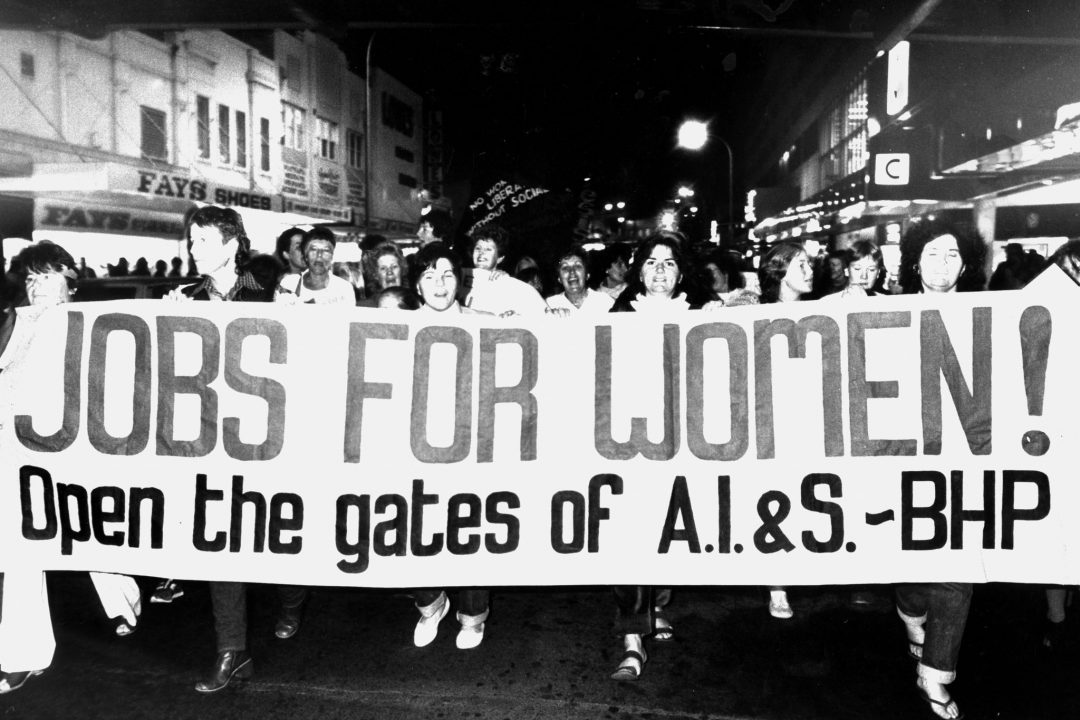
One of the longest-running sex discrimination claims in Australian legal
history focused on women at the Port Kembla Steelworks.
The settlement in
February 1994 of the Australian Iron and Steel Pty Ltd (AIS) case brought to an
end 14 years of public campaigning and litigation by over 700 women,
represented by PIAC with considerable assistance from Legal Aid NSW.
For many years prior to the litigation, hundreds of
women had sought work at the Port Kembla Steelworks, owned by AIS (a subsidiary
of BHP).
Although the introduction of the Anti-Discrimination
Act 1977 in New South
Wales mandated equal employment opportunities for women, discriminatory
attitudes in heavy industry continued to bar women’s employment. AIS excluded women
from certain work, telling them there were no jobs for women, despite hiring
men in similar roles.
In 1980, Donka Najdovska and 33 women affected by the
AIS hiring policy lodged complaints with the NSW Anti-Discrimination Board
(ADB). Following conciliation, AIS agreed to engage women as ironworkers,
employing over 150 at the steelworks.
But the victory was short-lived.
Within two years, a
downturn in the Australian steel industry prompted AIS to retrench many of the
women employed as a result of the initial claim.
The women claimed that their
retrenchments (executed in accordance with the ‘last on, first off principle’)
amounted to indirect discrimination, the earlier discriminatory conduct by AIS
delaying their initial employment.
In 1989, after a series of appeals by AIS,
the High Court held that AIS employment practices amounted to unlawful direct
and indirect discrimination, awarding the women approximately $1.4 million.
During this period, numerous additional complaints,
primarily from migrant women alleging similar conduct by AIS, had been lodged
with the ADB.
In a separate action, PIAC, led by then barrister (now
Justice of the NSW Court of Appeal) John Basten QC, acted
in representative proceedings on behalf of close to 300 women. The Equal
Opportunity Tribunal ultimately found that AIS had discriminated against all
women who had applied, or had applications pending, for employment as
ironworkers during the period from mid-1977 to the end of 1981.
Orders made in representative proceedings under the Anti-Discrimination
Act at the time could
only be made concerning liability and not damages.
So despite a positive
finding on liability, individual complainants were required to pursue
individual claims for damages through the ADB. Attempts to determine damages
were accompanied by an ever-increasing number of complainants, with the total
number of complainants growing to over 700.
In May 1993, after years of lobbying, publicity and strategic advocacy spearheaded
by the Jobs and Justice for Women Campaign, AIS and PIAC signed a mediation agreement with the
aim of settling all outstanding and potential complaints of sex discrimination
against AIS by women who had applied or who had an application pending for
employment as an ironworker with AIS between 1 June 1977 and 30 September 1988.
In January 1994, the last of the complaints of some 709 women were settled and
the legal proceedings were withdrawn.
Despite
arguments that the final mediated settlement of the AIS litigation undermined
and ‘privatised’ the public interest objectives and potential gains of
litigation (with disappointing consequences for some of the women in the
representative proceedings), the AIS case stands as a landmark in Australian
legal and industrial history.
The Jobs
for Women campaign, the
litigation and the national and international mobilisation of support for the
women combined to trigger significant changes to employment practices and
policies, including:
- demonstrating
the inefficiency of sex-segregated workforces and the need for flexible job
structures based on merit; - initiating
changes in attitudes to the employment and treatment of women with the
implementation of anti-discrimination and affirmative action workplace
policies; - reforming
OH&S manual handling legislation, enabling safer work practices for all
workers – both women and men.
The right to equal opportunity in the work place remains key to women’s
entitlement to work. The gains secured by Najdovska, Banovic, Murphy and others
against such a large company continue to influence and inspire Australian women
in their struggle to gain productive employment and ensure ongoing access to
work and long-term economic security.
Photo courtesy of the Illawarra Mercury; International Womens Day march on Crown St, Wollongong, 1984.
Return to Celebrating 30 years of public interest advocacy
Return to People power: commitment, energy and dedication